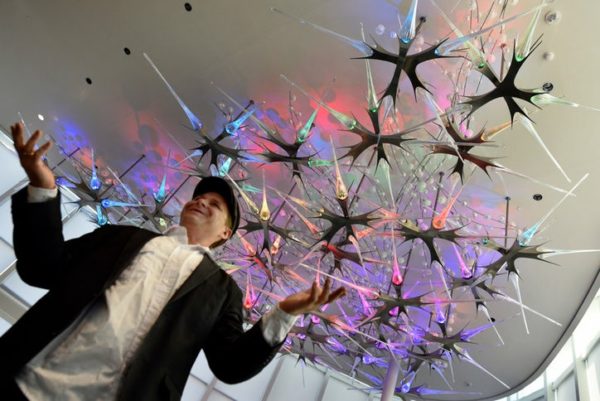North Texas researchers want to delve deeply into the intricacies of the human brain.
And to do it, they’re shoring up research programs, adding space exclusively for neurologists and creating consumer-facing centers that provide, among other things, brain check-up exams.
The efforts are being fueled by a growing national demand for neurological science, as well as the prevalence of conditions such as Alzheimer’s, autism and traumatic brain injuries.
ADVERTISING
“The reason you’re seeing more about the brain right now is that it’s time,” said Leanne Young, who heads the University of Texas at Dallas’ new Brain Performance Institute.
On Thursday, UTD’ Center for BrainHealth will officially open a 62,000-square-foot Brain Performance Institute on Mockingbird Lane. It will use virtual simulation technology to provide cognitive training for people with and without brain conditions.
For example, one of the uses is to help people with autism and other social cognition challenges to recognize emotions and facial expressions, and to view in real-time how their own expressions can affect other people.
“From a scientific point of view, there’s a huge amount of excitement” in the brain research world, said Dr. David Owens, acting deputy director of extramural research at the National Institute of Neurological Disorders and Stroke.

Glass artist David Gappa created this glass neuron installation titled “Introspection” to mimic the mind for the Brain Performance Institute at the Center for BrainHealth in Dallas.
(Ben Torres/Special Contributor)
The need to penetrate the mystery of the brain is urgent, as “this is one of the fundamental questions still to crack,” he said. When it comes to the research being done to move things forward, “Texas is well represented,” Owens added. Brain disorders and diseases cost the U.S. economy an estimated $1.5 trillion a year, or about 8.8 percent of the nation’s gross domestic product, according to a 2016 report from the Washington, D.C.-based tech policy group, the Information Technology and Innovation Foundation. In 2013, the National Institutes of Health launched The Brain Initiative, a $4.5 billion multiyear, multi-agency project to revolutionize scientific knowledge of the billions of neurons and cells that make up our noggins.
SPONSORED CONTENT
Hidden in plain sight: Dallas’ unique subway system
The initiative launched with partners from research foundations and institutes, drug and device makers and universities. The University of Texas System aligned more than $20 million in equipment, faculty and other resources to support the project. Texas organizations had already been paving a way for brain research across the state. And projects are expanding to address unmet needs and move research to new levels.
Both UTD and UT Southwestern announced new efforts in recent weeks. They are part of a systemwide priority to “move the needle” on brain research, as system chancellor William McRaven described during a visit to North Texas earlier this year. The projects are funded by federal and state monies, philanthropists and bonds.
UTD’ $82 million Brain Performance Institute was created predominantly with donations from philanthropists, whose contributions were matched by state funding. They raised over $19 million in private money for construction and received $15 million in matching funds from the state and university. The rest was used to cover programming, such as cognitive training for military veterans and law enforcement and reasoning programs for middle-school students. It’s a unique model that uses the latest science to focus on prevention, Young said. “Most of the time, people don’t think about their brain until something goes wrong,” she explained. “We’re looking at how can we prevent somebody from ever having to worry.” Services provided at the Brain Performance Institute, including post-acute care for people diagnosed with brain conditions, will not be covered by health insurance. Consumers would pay directly. The institute will also profit from helping companies design and develop brain healthy workplaces that enhance employee performance. Still, others remain focused on clinical research and treatments. “And there is always a need for more,” said William Dane, a spokesman for the Brain Injury Association of America. “More research, more beds and more clinicians,” he said.
Texas groups are stepping it up. Earlier this month, for example, UT Southwestern announced plans for a $480 million expansion of its William P. Clements Hospital. A $36 million gift from the O’Donnell Foundation helped to jump start the effort. It will include construction of a third tower, in which seven of the 10 floors will be home to the O’Donnell Brain Institute, where basic science, clinical trials and other research will be conducted. “The goal is to provide the very best and most comprehensive care to those in need today,” said Dr. Daniel Podolsky president of the UT Southwestern Medical Center. A rendering of the $480 million expansion of UT Southwestern’s flagship William P. Clements Jr. University Hospital.
(UT Southwestern)
While philanthropic funding helped launch the newest efforts at the two UT System facilities, brain researchers across the state have also taken advantage of NIH funding. So far in 2017, the National Institute of Neurological Disorders and Stroke has issued 221 awards totaling $83.1 million to Texas researchers, and the National Institute of Mental Health has issued 92 awards totaling $35.7 million to local organizations, both in and out of the UT System. They include the Baylor College of Medicine and Methodist Hospital Research Institute in Houston, Austin-based molecular diagnostic company Asuragen and Southern Methodist University. UT Southwestern has been awarded just over $19 million and UTD $2.7 million for brain, stroke and mental health research this year. There’s a downstream positive benefit to Texas’ “confluence of brain activity,” said Owens of the National Institute of Neurological Disorders and Stroke. “They build centers, bring people in. They recruit and then they develop new programs,” he said. And that could position Texas to be a hub of brain research breakthroughs in the future.
